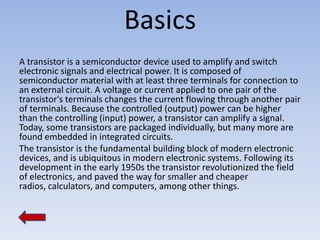The document provides information about transistors including their basics, history, comparison to vacuum tubes, and types. It discusses how transistors can amplify and switch electronic signals, and are composed of semiconductor material with at least three terminals. The history outlines how the transistor was invented in 1947 at Bell Labs as an improvement over vacuum tubes, with its smaller size and lower power consumption enabling many electronic devices. Transistors eventually replaced vacuum tubes in most applications. Transistors are also categorized in different ways such as by material, structure, polarity, power rating, and application.








